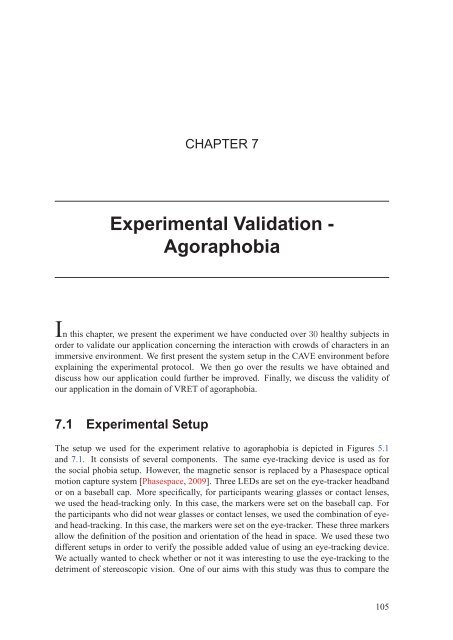Texte intégral / Full text (pdf, 20 MiB) - Infoscience - EPFL
Texte intégral / Full text (pdf, 20 MiB) - Infoscience - EPFL
Texte intégral / Full text (pdf, 20 MiB) - Infoscience - EPFL
Create successful ePaper yourself
Turn your PDF publications into a flip-book with our unique Google optimized e-Paper software.
CHAPTER 7<br />
Experimental Validation -<br />
Agoraphobia<br />
In this chapter, we present the experiment we have conducted over 30 healthy subjects in<br />
order to validate our application concerning the interaction with crowds of characters in an<br />
immersive environment. We first present the system setup in the CAVE environment before<br />
explaining the experimental protocol. We then go over the results we have obtained and<br />
discuss how our application could further be improved. Finally, we discuss the validity of<br />
our application in the domain of VRET of agoraphobia.<br />
7.1 Experimental Setup<br />
The setup we used for the experiment relative to agoraphobia is depicted in Figures 5.1<br />
and 7.1. It consists of several components. The same eye-tracking device is used as for<br />
the social phobia setup. However, the magnetic sensor is replaced by a Phasespace optical<br />
motion capture system [Phasespace, <strong>20</strong>09]. Three LEDs are set on the eye-tracker headband<br />
or on a baseball cap. More specifically, for participants wearing glasses or contact lenses,<br />
we used the head-tracking only. In this case, the markers were set on the baseball cap. For<br />
the participants who did not wear glasses or contact lenses, we used the combination of eyeand<br />
head-tracking. In this case, the markers were set on the eye-tracker. These three markers<br />
allow the definition of the position and orientation of the head in space. We used these two<br />
different setups in order to verify the possible added value of using an eye-tracking device.<br />
We actually wanted to check whether or not it was interesting to use the eye-tracking to the<br />
detriment of stereoscopic vision. One of our aims with this study was thus to compare the<br />
105

















